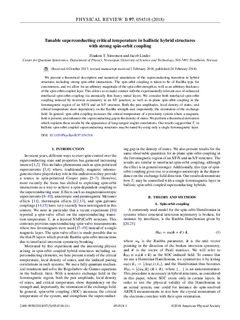Tunable superconducting critical temperature in ballistic hybrid structures with strong spin-orbit coupling
Journal article, Peer reviewed
Published version

Åpne
Permanent lenke
http://hdl.handle.net/11250/2592476Utgivelsesdato
2018Metadata
Vis full innførselSamlinger
- Institutt for fysikk [2701]
- Publikasjoner fra CRIStin - NTNU [38525]
Sammendrag
We present a theoretical description and numerical simulations of the superconducting transition in hybrid structures including strong spin-orbit interactions. The spin-orbit coupling is taken to be of Rashba type for concreteness, and we allow for an arbitrary magnitude of the spin-orbit strength as well as an arbitrary thickness of the spin-orbit coupled layer. This allows us to make contact with the experimentally relevant case of enhanced interfacial spin-orbit coupling via atomically thin heavy metal layers. We consider both interfacial spin-orbit coupling induced by inversion asymmetry in an S/F-junction, as well as in-plane spin-orbit coupling in the ferromagnetic region of an S/F/S- and an S/F-structure. Both the pair amplitudes, local density of states and critical temperature show dependency on the Rashba strength and, importantly, the orientation of the exchange field. In general, spin-orbit coupling increases the critical temperature of a proximity system where a magnetic field is present, and enhances the superconducting gap in the density of states. We perform a theoretical derivation which explains these results by the appearance of long-ranged singlet correlations. Our results suggest that Tc in ballistic spin-orbit coupled superconducting structures may be tuned by using only a single ferromagnetic layer.